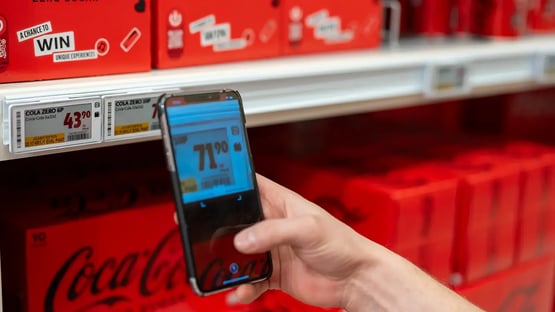The new era of retail digitization

As retailers turn towards increased digitization, as they look to fine-tune in-store operations in their search for efficiency to mitigate against a barrage of rising costs they face, Peter Ward, UK Country Manager at Pricer explores how cloud-based platforms are accelerating digital transformation in the store.
As margins tighten and consumer expectations evolve in response to shifting economic pressures, retailers are increasingly seeking smarter, more scalable ways to improve efficiency, enhance customer experience and stay competitive.
At the heart of this transformation is a quiet but significant revolution, cloud-based store digitization.
Cloud platforms are rapidly becoming the backbone of modern retail operations. These systems enable real-time, centralized control over pricing, inventory, and customer engagement across vast store networks.
By integrating technologies such as electronic shelf labels (ESLs), artificial intelligence (AI) and high-speed data processing into a unified ecosystem, retailers are unlocking new levels of agility and accuracy, while enabling store teams to focus more on customer interaction and less on routine tasks.
The power of centralization and scale
Traditional in-store systems, often fragmented and reliant on manual processes, are increasingly seen as outdated. Cloud-native platforms now offer centralized control that can eliminate the need for labor-intensive store-by-store updates.
This means retailers can synchronize pricing, stock levels and promotional content across hundreds or even thousands of stores almost instantly.
Such systems often deliver millions of real-time updates daily, supporting high-frequency, high-accuracy execution that would be impossible with manual approaches.
Built on modern cloud architectures like Kubernetes and hosted across global data centres, these platforms also ensure robust performance, enhanced security and compliance with regulations such as GDPR, SOC and ISO standards.
Enabling smart, human-centred retail
Digitisation in retail is not about replacing people, it’s about enabling them. By removing repetitive, low-value tasks like manual price changes or stock audits, staff are freed to focus on more meaningful, customer-facing roles.
Retailers adopting cloud-based digitisation often report significant productivity gains, with labour hours redirected from back-office functions to the shop floor. Dynamic pricing capabilities allow stores to adapt quickly to local conditions, promotions or supply fluctuations without operational disruption. Real-time inventory visibility also improves product availability, reducing customer dissatisfaction and missed sales.
Fast deployment and future-proof design
A significant advantage of cloud-based platforms is the speed of deployment. With modern integration tools, even complex store formats can be onboarded with full automation infrastructure in a matter of hours. This agility is crucial in a retail environment characterized by constant change and intense competition.
Fast rollout enables businesses to test new store formats, react quickly to market opportunities, or launch time-sensitive campaigns, without the delays typically associated with legacy systems.
AI, analytics and the cloud advantage
Beyond infrastructure, cloud platforms are increasingly supporting advanced capabilities, such as generative AI, predictive analytics, and app-based integrations. These features enable deeper customer engagement and operational intelligence, from real-time performance dashboards to personalized marketing tools.
Modular, cloud-native design also means new applications, such as loyalty programmes or visual merchandising optimisers, which can be seamlessly integrated, allowing for continuous innovation and adaptation at the store level. This might also enable identifying pricing anomalies, forecasting demand or managing energy consumption.
Rethinking the role of the physical store
As digital channels continue to grow, the role of the physical store is evolving from purely transactional to experiential. Cloud-based automation plays a crucial role in this transition, transforming stores into data-rich environments that adapt in real-time to customer needs. With tools that support everything from guided selling to interactive displays, retailers can create more personalized, seamless in-store experiences. This convergence of digital and physical touchpoints helps drive loyalty and conversion, particularly in sectors where human interaction and tactile experience still matter.
Building resilience and sustainability
Another emerging advantage of cloud-native retail platforms is their role in building business resilience and supporting sustainability goals. From more efficient energy management to reducing food waste through automated markdowns, these systems help retailers make smarter, more responsible decisions. Cloud infrastructure also allows for rapid adaptation in times of disruption, whether due to supply chain shocks, staffing challenges, or demand spikes, enabling retailers to maintain continuous service and protect margins under pressure.
A foundation for the future of retail
The shift from legacy systems to cloud-based automation is no longer a question of ‘if’ but ‘how fast.’ This transition is not just a technological upgrade, it’s a strategic move that positions retailers to lead in a fast-changing market.
Cloud-based platforms are the future of retail – connected, automated and intelligent. By combining reliable, energy-efficient technology with the performance and scalability of Google Cloud, retailers can redefine what’s possible at the shelf edge and transform it into a dynamic communication offer that informs, engages and sells.
By adopting scalable, intelligent and responsive retail digital solutions, businesses are laying the groundwork for a more agile and human-centric future. As cloud technologies continue to evolve, those investing today will be best equipped to shape tomorrow’s retail landscape.
If you would like to know how you can take the next step in digitizing your stores. Please reach out to us at Pricer.
This article was originally published in ISN Magazine on May 14, 2025.